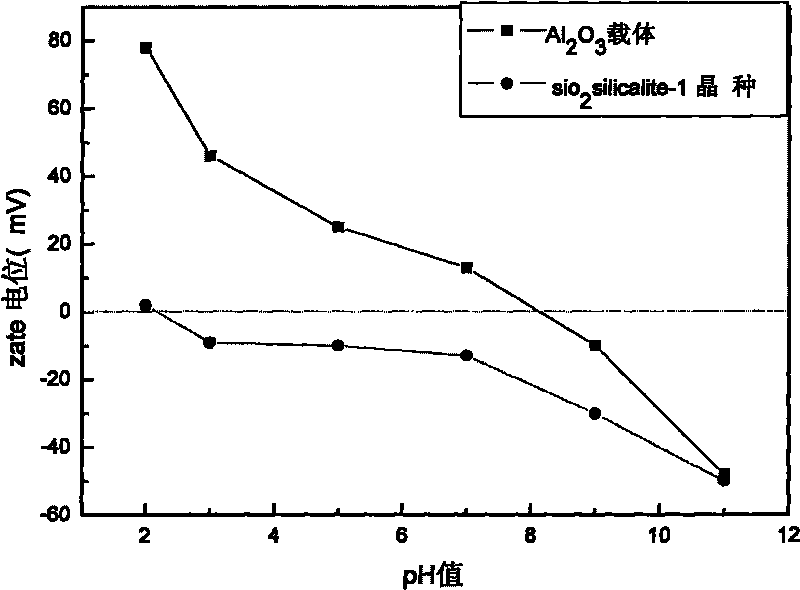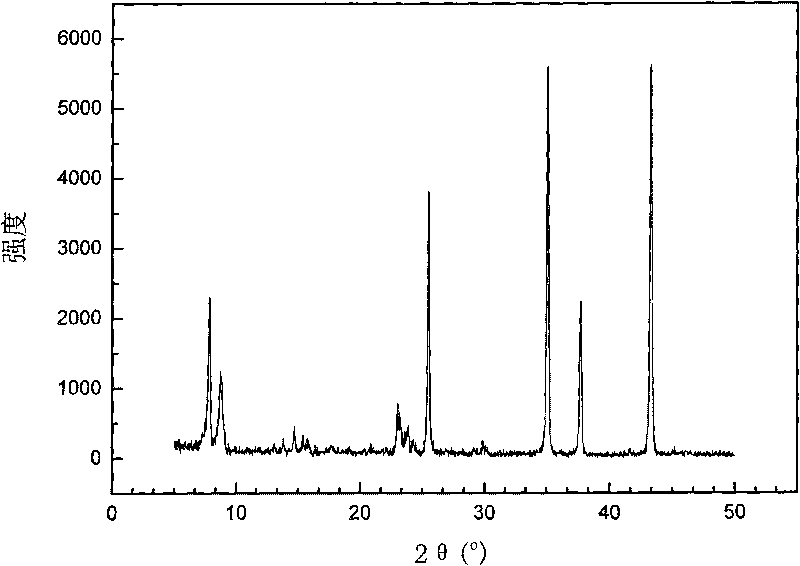Method for synthesizing silicalite-1 zeolite membranes
A synthetic method and technology of molecular sieves, applied in the direction of molecular sieve compounds, molecular sieves and base exchange compounds, chemical instruments and methods, etc., to achieve good repeatability
- Summary
- Abstract
- Description
- Claims
- Application Information
AI Technical Summary
Problems solved by technology
Method used
Image
Examples
Embodiment 1
[0028] The aluminum oxide with a thickness of 2 mm and a diameter of 20 mm is used as a carrier, its porosity is 45%, and the average diameter of the void is 0.2 μm. Carrier pretreatment: smooth one side of the carrier with 1000-mesh sandpaper, ultrasonic cleaning, and dry at 40°C for two days. stand-by.
[0029] Put the TPAOH (1M) solution in a sealable polytetrafluoroethylene conical flask, and dissolve sodium hydroxide in the solution, heat to 80°C, and at 500rpm, put the fumed silica at a speed of 0.2g per minute This was added in portions to the solution to give a clear solution in the ratio 1 g (silica): 5 ml (TPAOH): 0.7 g (sodium hydroxide). Cool naturally to room temperature and age for 3 hours. Pour the synthesis liquid into a reaction kettle, conduct hydrothermal crystallization at 120° C. for 0.5 days, prepare the obtained seed crystals into a 10-50% solution, and adjust the pH value to about 10.
[0030] A small amount of the above seed crystal solution was tak...
Embodiment 2
[0033] In this experiment, aluminum oxide with a thickness of 2 mm and a diameter of 20 mm was used as a carrier, and its porosity was 45%, and the average diameter of the voids was 0.2 microns. Carrier pretreatment: smooth one side of the carrier with 1000-mesh sandpaper, ultrasonic cleaning, and dry at 40°C for two days. stand-by.
[0034] Put the TPAOH (1M) solution in a sealable polytetrafluoroethylene conical flask, and dissolve sodium hydroxide in the solution, heat to 80°C, and at 500rpm, put the fumed silica at a rate of 0.2g per minute This was added in portions to the solution to give a clear solution in the ratio 1 g (silica): 5 ml (TPAOH): 0.7 g (sodium hydroxide). Cool naturally to room temperature and age for 3 hours. Pour the synthesis solution into a reaction kettle, conduct hydrothermal crystallization at 120° C. for 1 day, prepare the obtained seed crystals into a 10-50% solution, and adjust its pH value to about 10.
[0035]A small amount of the above see...
Embodiment 3
[0038] In this experiment, aluminum oxide with a thickness of 2 mm and a diameter of 20 mm was used as a carrier, and its porosity was 45%, and the average diameter of the voids was 0.2 microns. Carrier pretreatment: smooth one side of the carrier with 1000-mesh sandpaper, ultrasonic cleaning, and dry at 40°C for two days. stand-by.
[0039] Put the TPAOH (1M) solution in a sealable polytetrafluoroethylene conical flask, and dissolve sodium hydroxide in the solution, heat to 80°C, and at 500rpm, put the fumed silica at a rate of 0.2g per minute This was added in portions to the solution to give a clear solution in the ratio 1 g (silica): 5 ml (TPAOH): 0.7 g (sodium hydroxide). Cool naturally to room temperature and age for 3 hours. Pour the synthesis solution into a reaction kettle, conduct hydrothermal crystallization at 120° C. for 2 days, prepare the obtained seed crystals into a 10-50% solution, and adjust its pH value to about 10.
[0040] A small amount of the above s...
PUM
| Property | Measurement | Unit |
|---|---|---|
| thickness | aaaaa | aaaaa |
| diameter | aaaaa | aaaaa |
| porosity | aaaaa | aaaaa |
Abstract
Description
Claims
Application Information
 Login to View More
Login to View More - R&D
- Intellectual Property
- Life Sciences
- Materials
- Tech Scout
- Unparalleled Data Quality
- Higher Quality Content
- 60% Fewer Hallucinations
Browse by: Latest US Patents, China's latest patents, Technical Efficacy Thesaurus, Application Domain, Technology Topic, Popular Technical Reports.
© 2025 PatSnap. All rights reserved.Legal|Privacy policy|Modern Slavery Act Transparency Statement|Sitemap|About US| Contact US: help@patsnap.com



